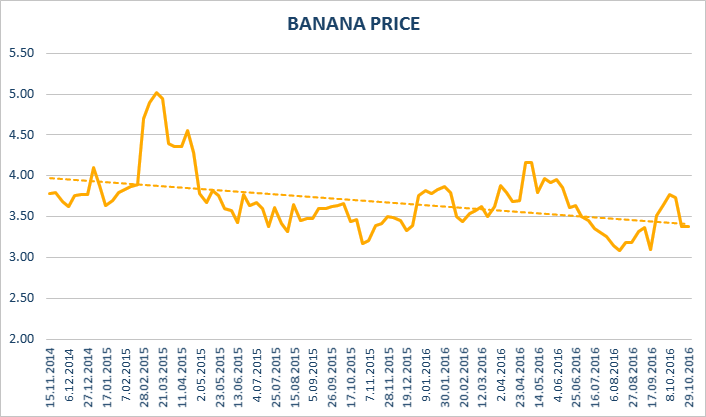Indexes
 03
November
2016
03
November
2016

 03
November
2016
03
November
2016
Georgian retail prices increased at the end of October. Driven by seasonal fruits and vegetables, ISET’s Retail Food Price index gained 2.2% m/m (compared to the last week of September). However, compared to October 2015, we still observed a significant 13.5% decline in food prices.
In the most noteworthy news, bi-weekly price increases were recorded for tomatoes (66%), cucumber (52%), and eggplant (29%). Despite an overall upward trend in food prices, some products are becoming cheaper. The biggest price declines were observed for tangerines (12%), rice (10%), and bananas (9.3%).
Compared to the previous month, bananas became cheaper: the average price of 1 kg of bananas went down, from 3.73GEL to 3.38GEL. Taking into account the fact that bananas are an imported fruit, one might look to the exchange rate for an explanation. However, the Georgian lari is experiencing depreciation. In October, the exchange rate between the Georgian lari and the U.S. dollar moved up from 2.32 to 2.42, compared to September. In other words, imports should be more expensive for Georgia. Therefore, the question is - what is wrong with bananas? We need to look for the answer in the world market. The international price of bananas has definitely declined. One possible reason might be a good harvest.
It is worth noting that the biggest banana importer countries for Georgia are Ecuador and Turkey. In September 2016, the price of imported bananas from Ecuador was 0.86USD; that is not significantly higher than in August 2016 (0.83USD). However, the price of imported bananas from Turkey has decreased from 0.72USD to 0.61USD (-15%) during the same period. It turns out that Georgian supermarkets are selling more bananas that are imported from Turkey, not that Georgian farmers have secretly started to produce bananas.
Figure 1: the dynamics of banana price






